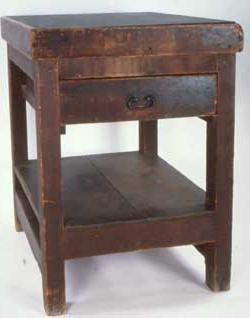Collections Online
Imposing stone for The Liberator
To order an image, navigate to the full
display and click "request this image"
on the blue toolbar.
-
Choose an alternate description of this item written for these projects:
- MHS 225th Anniversary
- Main description
[ This description is from the project: Witness to America's Past ]
The imposing stone on which William Lloyd Garrison composed type for his abolitionist newspaper, The Liberator, has been symbolically linked at the Massachusetts Historical Society with Daniel Chester French's bronze of the Liberator, Abraham Lincoln (no. 149), since the 1930s.
One of the first American abolitionists to demand immediate and complete emancipation of slaves, Garrison gave full voice to his radically abolitionist ideas in his newspaper, The Liberator. Each issue bore the motto "Our Country is the World, our Countrymen are all Mankind," and the very first issue on Jan. 1, 1831 concluded its lead story with Garrison's promise, "I am in earnest—I will not equivocate—I will not excuse— I will not retreat a single inch—and I will be heard." Intractable in his convictions, Garrison was subjected to threats and indignities and was literally tarred and feathered by a Boston mob in 1835. His reaction was predictable. "It seems to me that we ought to resolve that the Liberator, despite all opposition, shall continue to be printed—and printed, too, in Boston."1 For thirty-five years the newspaper did carry its message of liberation until it closed in 1865 after the conclusion of the Civil War.
This imposing stone, actually a thick sheet of slate encased in a pine stand, was used by William Lloyd Garrison for at least twenty years (1845-1865), and of it he wrote, "How many days and nights have I wearily bent over it in getting ready the paper for prompt publication! What a 'stone of stumbling' and a 'rock of offense' it was to all the enemies of emancipation!"2 After the Liberator closed, Garrison sold the stone to George W. Stacy of Milford, Massachusetts, a fellow printer and abolitionist, who likewise used it for twenty years (1866-1885), after which it reverted to the Garrison family.

